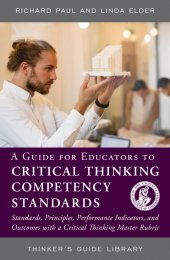A Guide for Educators to Critical Thinking Competency Standards: Standards, Principles, Performance Indicators, and Outcomes with a Critical Thinking Master Rubric
Richard Paul and Linda Elder
Contact Info for Bloomsbury:
- For questions about orders you have already placed, email weborders@mpsvirginia.com or telephone 888-330-8477, ext. 7527.
- For questions about eBook purchases or pre-orders, email contact@bloomsbury.com.
- For general enquiries not related to online orders, call 1 212-419-5300 or email contact@bloomsbury.com.
The Foundation for Critical Thinking has developed an authoritative system of competency standards to ensure successful and consistent integration of critical thinking skills in schools and educational programs at every level and in every discipline. The critical thinking competency standards articulated in this guide serve as a resource for teachers, curriculum designers, administrators and accrediting bodies.
As part of the Thinker’s Guide Library, this book advances the mission of the Foundation for Critical Thinking to promote fairminded critical societies through cultivating essential intellectual abilities and virtues across every field of study across world.
Pages: 56 • Trim: 5 1/2 x 8
978-0-944583-30-2 • Paperback • January 2007
978-1-5381-3393-4 • eBook • June 2019
Series:
Thinker's Guide Library
$25.20
Additional Information About:
A Guide for Educators to Critical Thinking Competency Standards: Standards, Principles, Performance Indicators, and Outcomes with a Critical Thinking Master Rubric
Critical Thinking Competency Standards provides a framework for assessing students’ critical thinking abilities. It enables administrators, teachers, and faculty at all levels (from elementary through higher education) to determine the extent to which students are reasoning critically within any subject or discipline. These standards include outcome measures useful for teacher assessment, self-assessment, as well as accreditation documentation. These competencies not only provide a continuum of student expectations but can be contextualized for any academic subject or domain and for any grade level. In short, these standards include indicators for identifying the extent to which students are using critical thinking as the primary tool for learning.
By internalizing the competencies, students will become more self-directed, self-disciplined, self-monitored thinkers. They will develop their ability to:
• raise vital questions and problems (formulating them clearly and precisely);
• gather and assess relevant information (using abstract ideas to interpret it effectively and fairly);
• come to well-reasoned conclusions and solutions (testing them against relevant criteria and standards);
• think open-mindedly within alternative systems of thought (recognizing and assessing, as need be, their assumptions, implications, and practical consequences); and
• communicate effectively with others in figuring out solutions to complex problems.
Students who internalize these competency standards will come to see that critical thinking entails effective communication and problem-solving skills, as well as a commitment to overcoming one’s native egocentric and sociocentric tendencies.
All students (beyond the elementary level) are expected to demonstrate all of the critical thinking competencies included in this battery of demonstrable skills, but not at the same level of proficiency, or in the same subjects or at the same speed. These competencies signal important habits of thought that manifest themselves in every dimension and modality of learning: for example, in student reading, writing, speaking, and listening, as well as in professional and personal activities. It is up to the teacher or institution to contextualize and sequence the competencies, for different disciplines, and at differing levels.
The simple truth is that teachers are able to foster critical thinking only to the extent that they themselves think critically. This may be the single most significant barrier to student achievement of critical thinking competencies. For teachers to aid students in becoming deep thinkers, they must themselves think deeply. For teachers to aid students in developing intellectual humility, they must themselves have developed intellectual humility. For teachers to foster a reasonable, rational multi-logical worldview, they must themselves have developed such a worldview. In short, teaching for critical thinking presupposes a clear conception of critical thinking in the mind of the teacher.
The critical thinking competency standards articulated in this guide serve as a resource for teachers, curriculum designers, administrators and accrediting bodies. The use of these competencies across the curriculum will ensure that critical thinking is fostered in the teaching of any subject to all students at every grade level.
Contents include:
SECTIONS ONE AND TWO: Focusing on elements of reasoning, and intellectual standards:
- Standard One: Purposes, Goals, and Objectives
- Standard Two: Questions, Problems, and Issues
- Standard Three: Information, Data, Evidence, and Experience
- Standard Four: Inferences and Interpretations
- Standard Six: Concepts, Theories, Principles, Definitions, Laws, & Axioms
- Standard Nine: Assessing Thinking
SECTION THREE: Focusing on intellectual traits, virtues or dispositions:
- Standard Ten: Fairmindedness
- Standard Eleven: Intellectual Humility
- Standard Twelve: Intellectual Courage
- Standard Thirteen: Intellectual Empathy
- Standard Fourteen: Intellectual Integrity
SECTION FOUR: Barriers to the development of rational thought:
- Standard Eighteen: Insight into egocentric thought
- Standard Nineteen: Insight into sociocentric thought
SECTION FIVE: Critical thinking skills essential to learning:
- Standard Twenty-Two: Skills in the Art of Close Reading
- Standard Twenty-Three: Skills in the Art of Substantive Writing
SECTION SIX: Focusing on specific domains: examples:
- Standard Twenty-Four: Ethical Reasoning Abilities
- Standard Twenty-Five: Skills in Detecting Media Bias and Propaganda in National and World News
